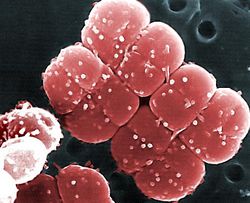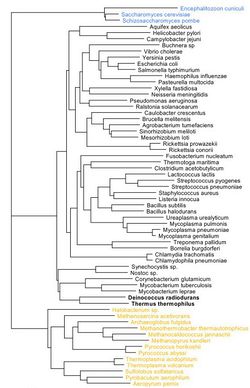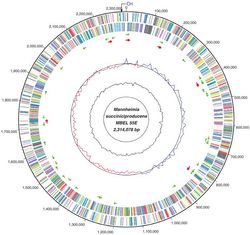Deinococcus radiodurans NEU2011: Difference between revisions
| Line 84: | Line 84: | ||
=='''Cool Factor'''== | =='''Cool Factor'''== | ||
Deinococcus Radiodurans is known as the world’s strongest bacteria. It is capable of surviving in high radiation. “The bacterium Deinococcus radiodurans, the present gold-medalist of radiation resistance, is widely considered an extremophile par excellence” [http://www.cook.rutgers.edu/~dbm/naturelifeextreme.pdf (8).] Many scientists have been studying their ability to survive in condition such as “5 megarads of γ-irradiation and up to 1,000 J of UV irradiation/m2 without mutation” [http://www.ncbi.nlm.nih.gov/pmc/articles/PMC151957 9.] The results that were found are that they are able to survive in such conditions due to two genes that were found: sig1 and sig2. These two genes are mutants and a Deinococcus Radiodurans bacterium that contains the sig 1 gene is capable of living in even more severe environments. Since it can survive in such harsh environments it has become a good candidate for radioactive waste cleanup. They have been use for the complete degradation of toluene in sites where there’s contamination [10] | Deinococcus Radiodurans is known as the world’s strongest bacteria. It is capable of surviving in high radiation. “The bacterium Deinococcus radiodurans, the present gold-medalist of radiation resistance, is widely considered an extremophile par excellence” [http://www.cook.rutgers.edu/~dbm/naturelifeextreme.pdf (8).] Many scientists have been studying their ability to survive in condition such as “5 megarads of γ-irradiation and up to 1,000 J of UV irradiation/m2 without mutation” [http://www.ncbi.nlm.nih.gov/pmc/articles/PMC151957 9.] The results that were found are that they are able to survive in such conditions due to two genes that were found: sig1 and sig2. These two genes are mutants and a Deinococcus Radiodurans bacterium that contains the sig 1 gene is capable of living in even more severe environments. Since it can survive in such harsh environments it has become a good candidate for radioactive waste cleanup. They have been use for the complete degradation of toluene in sites where there’s contamination [http://mic.sgmjournals.org/cgi/reprint/152/8/2469 10.] Not only that they are able to repair their damage in only an hour which is a short amount of time. Unlike most other bacteria that have only one DNA it has four to ten DNA. According to data this specific bacteria is known as one of the oldest life forms on earth originating about 2 billion years ago. One of the theories that scientists have is that it is originally from outer of space but this was prove to be wrong. | ||
=='''References'''== | =='''References'''== | ||
Revision as of 03:56, 8 April 2011
Deinococcus Radiodurans
Classifications
Higher Taxa
- Kingdom: Bacteria
- Phylum: Deinococcus-Thermus
- Order: Deinococcales
- Family: Deinococcaaceae
- Genus: Deinococcus
- Species: Radiodurans
Description and Significance
Deinococcus Radiodurans is a spherical bacteria 1-2 μm in diameter that tends to form tetrads and is extremely resistant to radiation. It is red in color and non-motile as well as nonsporulating. It is found in many places worldwide, from soil, elephant dung, and granite in Antarticas dry valleys. It was first isolated in 1956 when canned meat that spoiled even though it had been exposed to radiation.
Another unique feature of D. radiodurans is that it has multiple copies of its genome. During the exponential growth phase D. radiodurans will have 8-10 copies of its genome. During the stationary growth phase it will still have 4 copies of its genome, which consists of 2 chromosomes, 1 megaplasmid, and 1 plasmind.
Deinococcus Radiodurans is highly resistant against Ionizing radiation, Ultraviolet radiation, oxidative stress, and desiccation. Although radiation causes a delay in growth and replication briefly D. radiodurans can recover from 15kGy of gamma radiation, a level that is deadly to most life. D. radiodurans is 50 times more resistant than E. coli to ionizing radiation and about 33 times more resistant than E. coli to ultraviolet radiation. It is no less susceptible to the damage that radiation causes than other cells, but is however much better at repairing its genome when radiation causes double stranded breaks (DSB). E. coli can withstand about 10-15 DSB’s, while D. radiodurans is able to repair 1,000-2,000 DSB’s. It is theorized that perhaps D. radiodurans is able to use the multiple copies of its genomes to find templates for repair when mending DSB’s. Many people wondered what selective pressure caused D. radiodurans to develop such extreme resilience to radiation when no such conditions are present on earth. It is postulated that it was severe dehydration, which can cause similar DNA damage to radiation was the pressure that lead to the evolution of D. radiodurans.
D. radiodurans has been of fascination to researchers who are eager to understand its amazing DNA repair mechanisms. It also has been of useful as a genetically engineered bacteria. It has been recombined to be capable of metabolizing toxic toluene and mercury from radioactive waste, as it can survive in the extreme radioactive conditions.
Genome structure
The genome is composed of four circular molecules:
- Chromosome I = 2,648,638 base pairs
- Chromosome II = 412,348 base pairs
- A megaplasmid = 177,466 base pairs
- A plasmid = 45,704 base pairs
The genome contains 3187 open reading frames (ORFs), with an average size of 937 base pairs (bp), representing 91% of the genome.Analysis of the genome shows that almost 30% of the total number of genes encodes proteins with regulatory functions (39 of 140) including: transcription factors, response regulators, and kinases are found on chromosome II and the megaplasmid.(3)
Cell Structure and Metabolism
Deinococcus Radiodurans is a obligate aerobe that is chemoorganotrophic (Battista). This bacterium however has been recombined in order for it to be able to metabolize various radioactive toxic waste, such as toluene and mercury. It is cocci shape bacterium that stains gram positive although it’s cell structure more closely resembles that of a gram negative cell. It has an outer and an inner membrane and a thicker peptidoglycan layer that is 14-20nm thick. On top of the peptidoglycan layer there is another layer that is broken up into many small compartments.
Ecology
The habitat of Deinococcus Radiodurans is not well defined. They can be found in a wide variety of habitats. However a lot of them are dependent on water which limits the areas in which they can be found. They are widely distributed in the soil and can be found in every continent. It has also colonized ground meat and sewage. Many colonies have been isolated from including radiation sterilized surgical tools, filtered air, and elephant waste. There ability to withstand extreme environment also makes it easy for them to live in almost every habitant on the planet. They are able to survive in nutrient poor environments and dry places because they have also been isolated from dried food, musical instruments, and room dust.(208)
Pathology
Currently, Deinococcus Radiodurans is not proven to be a pathogenic organism. Most studies on Deinococcus Radiodurans provide hope for it to be used in research as an agent that can be genetically altered to serve an important role in getting rid of toxins.
Current Research
Cool Factor
Deinococcus Radiodurans is known as the world’s strongest bacteria. It is capable of surviving in high radiation. “The bacterium Deinococcus radiodurans, the present gold-medalist of radiation resistance, is widely considered an extremophile par excellence” (8). Many scientists have been studying their ability to survive in condition such as “5 megarads of γ-irradiation and up to 1,000 J of UV irradiation/m2 without mutation” 9. The results that were found are that they are able to survive in such conditions due to two genes that were found: sig1 and sig2. These two genes are mutants and a Deinococcus Radiodurans bacterium that contains the sig 1 gene is capable of living in even more severe environments. Since it can survive in such harsh environments it has become a good candidate for radioactive waste cleanup. They have been use for the complete degradation of toluene in sites where there’s contamination 10. Not only that they are able to repair their damage in only an hour which is a short amount of time. Unlike most other bacteria that have only one DNA it has four to ten DNA. According to data this specific bacteria is known as one of the oldest life forms on earth originating about 2 billion years ago. One of the theories that scientists have is that it is originally from outer of space but this was prove to be wrong.
References
.
- http://www.scifun.ed.ac.uk/card/facts.html
- http://bioweb.uwlax.edu/bio203/s2008/arnold_meag/Phylogeny.htm
- Battista JR. Against all odds: the survival strategies of Deinococcus radiodurans. Annu Rev Microbiol. 1997;51:203-24. Review. PubMed PMID: 9343349.
- Makarova K, Minton K, et al. Genome of the Extremely Radiation-Resistant Bacterium Deinococcus radiodurans Viewed from the Perspective of Comparative Genomics. Microbiology and Molecular Biology Reviews. March 2001. Volume 65. p. 44-79.
- White O, Eisen JA, Heidelberg JF, Hickey EK, et al. Genome sequence of the radioresistant bacterium Deinococcus radiodurans R1. Science. November; 1999. 19;286 (5444) : 1571-7.
- "RamblingSoul." BioWeb Home. Web. 31 Mar. 2011. <http://bioweb.uwlax.edu/bio203/s2008/arnold_meag/>.
7. http://www.nsf.gov/news/frontiers_archive/10-96/10bugs.jsp
8. Rothschild, Lynn. "Life in Extreme Environments." Nature 409 (2001): 1092-101. Print.
9. Schmid, A. K., and M. E. Lidstrom. "Involvement of Two Putative Alternative Sigma Factors in Stress Response of the Radioresistant Bacterium Deinococcus Radiodurans." Journal of Bacteriology 184.22 (2002): 6182-189. Print.
10. Brim, H. "Deinococcus Radiodurans Engineered for Complete Toluene Degradation Facilitates Cr(VI) Reduction." Microbiology 152.8 (2006): 2469-477. Print.



